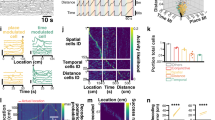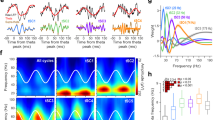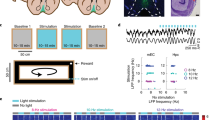Abstract
Hippocampal theta rhythm is crucial for spatial memory and is thought to be generated by extrinsic inputs. In contrast, using a complete rat hippocampus in vitro, we found several intrinsic, atropine-resistant theta generators in CA1. These oscillators were organized along the septotemporal axis and arose independently from CA3. Our results suggest that CA1 theta rhythm can emerge from the coupling of multiple autonomous hippocampal theta oscillators.
This is a preview of subscription content, access via your institution
Access options
Subscribe to this journal
Receive 12 print issues and online access
$209.00 per year
only $17.42 per issue
Buy this article
- Purchase on Springer Link
- Instant access to full article PDF
Prices may be subject to local taxes which are calculated during checkout



Similar content being viewed by others
References
Hasselmo, M.E. Hippocampus 15, 936–949 (2005).
Traub, R.D., Miles, R. & Wong, R.K. Science 243, 1319–1325 (1989).
White, J.A., Banks, M.I., Pearce, R.A. & Kopell, N.J. Proc. Natl. Acad. Sci. USA 97, 8128–8133 (2000).
Amaral, D.G. & Witter, M.P. Neuroscience 31, 571–591 (1989).
Bland, B.H. Prog. Neurobiol. 26, 1–54 (1986).
Buzsáki, G. Neuron 33, 325–340 (2002).
Vanderwolf, C.H. Electroencephalogr. Clin. Neurophysiol. 26, 407–418 (1969).
Kramis, R., Vanderwolf, C.H. & Bland, B.H. Exp. Neurol. 49, 58–85 (1975).
Leutgeb, S., Leutgeb, J.K., Treves, A., Moser, M.B. & Moser, E.I. Science 305, 1295–1298 (2004).
Lubenov, E.V. & Siapas, A.G. Nature 459, 534–549 (2009).
Fox, S.E., Wolfson, S. & Ranck, J.B. Jr. Exp. Brain Res. 62, 495–508 (1986).
Csicsvari, J., Hirase, H., Czurko, A., Mamiya, A. & Buzsaki, G. J. Neurosci. 19, 274–287 (1999).
Crépel, V., Khazipov, R. & Ben-Ari, Y. J. Neurophysiol. 77, 2071–2082 (1997).
Andersen, P. & Eccles, J. Nature 196, 645–647 (1962).
Cobb, S.R., Buhl, E.H., Halasy, K., Paulsen, O. & Somogyi, P. Nature 378, 75–78 (1995).
Acknowledgements
We thank M. Danik, G. Ducharme, C.K. Young, C.T. Dickson and G. Buzsaki for their comments on the manuscript. This work was supported by the Canadian Institute of Health Research, the Natural Sciences and Engineering Research Council of Canada and the Fonds de la Recherche en Santé du Québec. R.G. was supported by the Conrad F. Harrington post-doctoral fellowship from the McGill Faculty of Medicine. J.J. received a Canadian Graduate Scholarship from the Natural Sciences and Engineering Research Council of Canada and S.W. is a Fonds de la recherche en santé du Québec chercheur boursier ''senior.''
Author information
Authors and Affiliations
Contributions
R.G., J.J. and S.W. designed the experiments, R.G. and J.J. performed the experiments and analyzed the data, and R.G., J.J. and S.W. wrote the paper.
Corresponding author
Supplementary information
Supplementary Text and Figures
Supplementary Figures 1–13, Supplementary Table 1, Supplementary Methods and Supplementary Discussion (PDF 1827 kb)
Rights and permissions
About this article
Cite this article
Goutagny, R., Jackson, J. & Williams, S. Self-generated theta oscillations in the hippocampus. Nat Neurosci 12, 1491–1493 (2009). https://doi.org/10.1038/nn.2440
Received:
Accepted:
Published:
Issue Date:
DOI: https://doi.org/10.1038/nn.2440
This article is cited by
-
Tau in cerebrospinal fluid induces neuronal hyperexcitability and alters hippocampal theta oscillations
Acta Neuropathologica Communications (2023)
-
Acetylcholine modulates the temporal dynamics of human theta oscillations during memory
Nature Communications (2023)
-
Degeneracy in epilepsy: multiple routes to hyperexcitable brain circuits and their repair
Communications Biology (2023)
-
Behaviourally modulated hippocampal theta oscillations in the ferret persist during both locomotion and immobility
Nature Communications (2022)
-
The role of inhibitory circuits in hippocampal memory processing
Nature Reviews Neuroscience (2022)



